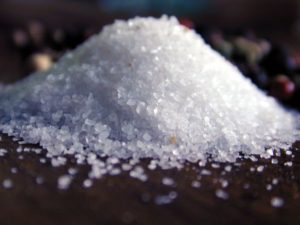SALT IS OUR first taste.
About five weeks into a pregnancy, when we’re still embryos, our nervous systems start to form. The cells that will become the brain and spinal cord divide and cluster. At the same time, our taste buds start developing alongside our tongues. A few weeks pass, and our buds eventually link up with our brain through the seventh, ninth, and tenth cranial nerves, at the end of which is our gustatory cortex. It sits in the center of our brain like the pit of an avocado. With this link in place, we still need eight more weeks for our taste buds to develop taste receptors, little pores that allow us to sense the flavors in our food. At that point, we can taste.
And the first taste we experience is salt. It comes from the amniotic fluid that surrounds us and has a flavor similar to sea water. I know because the other day I made a batch.
“It has the brightness of the sea,” said my wife, turning over the spoonful of salty water. She was a little over sixteen-weeks pregnant, the moment when a fetus’s senses come online, and her belly billowed like the tiny sail on a toy schooner. “But something’s missing.”
My wife has a good palate. She couldn’t have known I’d used a fleur de sel to approximate the 98% water and 2% salt that makes up amniotic fluid. Ever since we’d starting reading about fetal development, I’d been curious as to what the baby would be tasting. Concocting amniotic fluid seemed like a good way to find out.
I confess that, when I came out of the kitchen with a pint-sized Mason jar and a spoon, I didn’t tell her that the whitish water swirling in the glass was amniotic fluid. For the last few weeks, she’d been repulsed by foods she ordinarily loved. Kale, eggs, and chicken now turned her stomach, so I figured I wouldn’t introduce my little experiment with “Hey honey, let’s sample the liquid in your womb.” Instead, I tasted it first—nothing to fear here—then said, “Try this.”
“There’s no taste of seaweed,” she continued. “No funk. No dead thing floating in it, like you get at the shore.”
That’s because there’s a live thing floating in it—a fetus!

Our First Taste Sensation…
~
Sometimes what a husband doesn’t say shows he cares. I didn’t say that. Instead, I calmly listed the ingredients then calmly explained how they calmly approximated amniotic fluid. When I finished, I may have seen her cheeks convulse (“I wish I’d has some warning”), but on the whole she was game. No reason to let her know that, in a few more weeks, the amniotic fluid in her belly would include our baby’s urine. That funk she was missing would arrive soon enough. I simply focused on my own salty mouthful and saw she was right: the taste was very clean.
“Umami!” she declared, her buds fully recovered, “that’s what’s missing!”
Umami is a taste identified in 1908 by the Japanese scientist Kikunea Ikeda. He found that glutamate, an amino acid found in salt but not identical to it, was the taste that gave a succulent flavor to broth made out of seaweed. He named it “umami,” but non-foodies usually call it “savory.” It’s the taste in soy sauce, parmesan cheese, and anchovies that imparts their deep, rich flavors.
Baby, it appeared, would not be tasting deep, rich flavors in the womb. Which raised the question: what flavors would baby taste? Would saltiness be the only one? A baby destined for nothing more, gastronomically speaking, that a bag of potato chips? What about sweetness? What about sour and bitter? What, in short, could a father-to-be do to ensure the widest taste experience for his child at the very moment that he, that she (because we’d decided not to find out the baby’s sex) is first able to experience the world through taste?
I decided on nothing less—what else do you expect of a first-time father?—than giving our baby the world.
~
Now, I’ll eventually describe this global culinary journey, one that I cooked up for a creature who has yet to develop the ability to swallow, but what I really hope to do is show how we enter into the world of taste. How, that is, we make our journey from fetus to flavor to the foods we’ll eat long after we leave our mothers’ arms. And to do that, I first need to explain how it feels, as a father, to track the development of your newly conceived baby.
For starters, you don’t enter into it until the third week. That’s right, the pregnancy clock officially begins when a woman menstruates for the final time before conception. It takes two weeks for an egg to bobble from the ovary down the Fallopian tube, where, in week three, it meets up with one of your sperm. This is your big moment. At conception, you contribute half the genetic material that will eventually become a baby. Half baby’s gangly limbs and spotty moles, half its bad teeth and moodiness come from you. And then, as far as you’re concerned, that’s pretty much it. Thanks, Mr. Ejaculate, mom’s got it from here.
And what mom does, in all its developmental complexity, is marvelous. In the fourth week, she provides baby with a uterus, so it can burrow and grow. She also starts nourishing baby through her own blood. You, if you’re smart, will wave the pregnancy test enthusiastically without flinching at its pee-soaked end.
The following week, mom gives baby blood cells, kidney cells, nerve cells. Here’s the beginning of a brain, kid. Here’s the start of a heart. How about a spinal cord, would you like one of those? And you, dad, you lovingly dish out a prenatal vitamin that your wife ordered three months before she became pregnant.
Weeks six and seven, mom gives baby arms and legs, eyes and ears, a spinal cord, a heartbeat, bones. Dad gives nothing.
Week eight, mom provides a pair of lungs. Week nine, she follows up with hair follicles, nipples, those tiny toes and fingers that you’ll feature in the photos from the hospital. She also gives baby every organ. And don’t forget that mom has grown an entirely new organ herself, just for baby. Her placenta is feeding baby eliminating baby’s waste, and protecting baby from disease. You purchase the wrong flavor of ice cream.
On it goes. Mom gives the baby eyelids, nails, facial features, skin. She’s the prime mover for all of baby’s biological systems—circulatory, muscular, endocrine, nervous, digestive—all while you gain five pounds of sympathy weight.
So, at sixteen weeks, when baby can finally perceive the outside world, when its sense of hearing kicks in and touch becomes possible, when it can finally taste, for the very first time in its existence, of course you, as baby’s father, want to make it something special.
~
The pressing question becomes: what, besides salt, can baby taste?
We quickly discovered one answer. My wife had yet to feel the baby move. She might have—maybe, perhaps, she wasn’t entirely sure—felt a flutter one night after I had dozed off and she said to the ceiling, “Baby, do something.” Maybe, at that request, baby moved. She’s certain, however, that a few nights later, while we were once again lying in bed, she felt it. She sprang up, and her eyes brightened.
“The baby’s moving,” she gasped, in a low voice, as though she might spook it.
“What’s it feel like?” I asked
She cupped her stomach. “Like that wire brush you use to play the cymbal.” She demonstrated, moving her fingers to a soundless tune. “But inside.”
“Is it still happening?”
“Yes. No.” She hadn’t moved. “Maybe.”
Neither of us breathed.
“It’s gone,” she announced, a smile still gripping her cheeks.
Let me pause on this beatific moment and mention that my wife, with her fine palate, had of late not only been rejecting some of her favorite foods. She’d also been gripped by certain cravings. Cravings for pasta. Cravings for cookies and crusty bread and other carb-loaded foods that beckoned to her in the bakery and stalked her in the check-out line. Still worse for a woman who prides herself on her ability to cook up dal makahini from memory, she was craving clichés. Pickles, yes, pickles. And ice cream, in both the wrong and the oh-so-right-just-one-more-bite flavors.
So when I pointed out how baby must have enjoyed the pralines and cream that she’d polished off earlier, I thought I was saying the obvious. I was wrong.
“Oh no,” she said, slumping over her belly. “I’ve given the baby type 2 diabetes.”
“You can’t give the baby type 2 diabetes with Häagen Dazs.”
“You can,” she groaned. “I read about it. Gestational diabetes.”
“You had three bites. That’s like a sip of soda. Most Americans brush their teeth with soda.”
“Still,” she waivered, unconvinced.
For the rest of the night, we returned to the question of whether a mother could ruin her baby’s current health and dietary future by savoring three spoonfuls of Häagen Dazs. Suddenly that hamburger last Tuesday and those enchiladas on Friday and the fact that my wife had eaten only one salad the day before seemed to her like inevitable precursors to baby’s insulin shots, EpiPens, and eventual appearance on The Biggest Loser. “My mother,” baby would sob, “ruined me before I was born.”

For All Your Needs…
~
I hoped a few hours sleep would shake this worry from us, but the next morning my wife sent me a link to an article informing me that your baby “tastes what you taste — and research has shown that the foods you consume during this time help shape what your baby will enjoy eating, even years later.” Her subject heading was “Grilled Cheese Baby, Here We Come.”
Our baby was transforming from a belly full of joy into a meal you could buy at a gas station. Mildly concerned, I looked into the research. The upshot, once you click your way from the pregnancy websites to the newspaper reports to the scientific papers themselves, is what you’d expect: baby’s diet and health pretty much follows mom’s diet and health. Grilled Cheese Mom, Grilled Cheese Baby. Kale Mom, Kale Baby.
This simple dynamic results from a complex mix of biology and culture. We’re hard-wired to want sugar, salt, and fat—foods once scarce in human existence and now abundant beyond our ability to process them. But how and how much of these foods we eat when we’re infants has to do with cultural factors, such as our ethnicity and economic status, factors that show up most immediately in our families’ behavior around food. Unsurprisingly, your chances of avoiding gestational diabetes are much better if you’re conceived by an educated and healthy mother who has access to wholesome foods and an income to afford them.
The surprise is the sheer power of what researchers call the “cafeteria” or “junk-food” diet to affect a fetus.
As my wife and I learned, if mom spikes her blood sugar with Häagen Dazs, baby will react, so much so that some babies overexposed to sugar in the womb are born “addicted” to it. In certain cases, doctors need to provide newborns with a glucose drip in order to reduce their dangerously high insulin levels. Babies also show a clear preference for bottles that have had their latex nipples dipped in a sugar solution, and sugar can even work as an analgesic on infants. A baby enjoying sugar will endure more pain. Those warnings we’re now hearing about the toxic effects of sugar apply all the more to developing babies, who have about as much chance to resisting it as any other addictive drug.
In our Age of the Big Gulp, the sugar baby is the new crack baby.
~
So, yes, baby liked the taste of sweet. And I soon found myself pausing in the freezer aisle. How much Häagen Dazs is too much Häagen Dazs? Do those little Dixie-cup-size containers really count? The questions nagged at me, but they took a larger toll on my wife.
“Eating anything processed now feels to me like drinking french-fry oil.”
“You’re doing fine,” I assured her. Ever since my wife had found out she was pregnant, our refrigerator had looked like an ad for Whole Foods.
“What if the baby needs magnesium this week, and I’m not tracking my milligrams of magnesium.” She spat out the magnesium as if it disgusted her. “And one day I’ll have to say, ‘Sorry, baby, I just didn’t care enough about you to track my magnesium! So you don’t get whatever you should get that’s made of magnesium!’”
I wondered aloud, to no one in particular, if it might be worth having an occasional glass of wine to relive the stress of worrying about a prenatal diet.
“The pregnancy guide says that experts say that the prenatal research says that expecting mothers should be eating multiple meals a day. Not just three.” She was reading the guide, I should probably note, while eating a chocolate chip cookie.
“You have those snacks.”
“Maybe I should eat half of my lunch at lunch and then eat the other lunch later.”
“Maybe double every meal and eat all day?”
My wife looked up from the guide and released a long breath that began as a hiss and ended as a sigh.
~
Fortunately, the research out there offers more than information meltdown. The good news is that, if mom eats healthfully, she can not only create a healthier baby, but also shape baby’s future eating habits for the better.
Take a vegetable like carrots. Researchers at the Monell Chemical Senses Center designed an experiment to find out whether pregnant women and new mothers who drink carrot juice would have babies who also liked it. One group of women was asked to drink carrot juice regularly during their last trimester. Another group was asked to drink it during their first three months of breast feeding. The final group didn’t drink it at all. When their babies were six-months old, the women in all three groups “exposed” their babies to carrot juice by mixing it in cereal.
The results? Those babies whose mothers had drunk carrot juice, either while they were pregnant or while they were breast-feeding, “exhibited fewer negative facial expressions” than the babies whose mothers hadn’t had any carrot juice. The flavor of the carrot, in the amniotic fluid and in the mother’s milk, had made a difference in the babies’ response. Some babies, I suppose, made yuck-yuck faces, while those babies more inclined to carrots made single-yuck faces. I can picture the mothers staring at their babies the way an insecure chef might scrutinize a restaurant critic: how much does this guy hate my dish?
So if, like me, you’re thinking that fewer negative facial expressions isn’t exactly a triumph when it comes to getting a baby to like certain foods, keep in mind that babies normally need to experience a new taste eight to ten times before they’ll start eating it. Everything gets spit on the feeding tray at first. Like fussy critics, getting babies to like certain foods takes time.
And yet the carrot juice shows us this process starts in the womb. Researchers have found that the flavors of fruit, vegetables, and spices show up in amniotic fluid a few hours after a pregnant woman has eaten them. Even perfume and cigarette smoke, when inhaled by mothers-to-be, make it into the womb.
“Dietary learning” is the phrase used by Julie Mennella, one of the researchers behind the carrot experiment, to describe this process. As a fetus, then as an infant, the tastes that we experience as our mothers eat prepare us for the tastes we’ll experience once we start eating by ourselves. We learn what our future diets will be like from our mothers and, to a large extent, from what our mothers like.
~
In light of this research, I devised a plan for baby’s dietary learning and, after days of preparation, shared it with my wife.
“Our goal,” I said, flashing the first slide of my PowerPoint presentation and displaying a close-up of her rounded belly, “is to take advantage of this moment when baby can finally taste. What we want is to give baby the widest possible range of tastes.”
She nodded cautiously.
Next slide: an image of brilliantly colored spices—rusty orange, midnight blue, berry red—piled in grainy heaps.
“The challenge,” I said, “is that only the strongest tastes are able to flavor the amniotic fluid.” I glanced at my wife. “Garlic, for example.”
“Yes,” she said, less intrigued than braced.
“So we’ll be using the most powerful spices occurring in nature.” Another look.
”We?”
Next slide: a map of the world, marked with six red dots. “Our other goal,” I continued, “is to ‘expose’ baby to as many global cuisines as possible.” I thought I sounded impressive using the scientific lingo.
“Ambitious,” my wife said.
“Think of it as baby’s first study-abroad program, in utero.”
I then clicked through a series of slides, highlighting the six meals that I would cook in the next six days, meals that would take us, culinary, around the world. We would begin with the street vendors in Vietnam and, from there, travel to the hearths of Northern India. Then onward we’d go, finding our way to a table in Tunisian, and then we’d head north, into the icy Norwegian sea. From there, at last, we’d cross the Atlantic Ocean and land on the shores of the arid Yucatán Peninsula, all before arriving back home, in Ohio, on what would fortuitously be the Fourth of July.
Our travels would cover approximately 29,000 imaginary miles, more than the circumference of the earth. It would cost more real dollars than I’m going to admit. And it would dirty every dish we had in the house multiple times over. After we were done, I would never want to travel again, and I’d accomplish this culinary feat all without ever leaving the kitchen.
“Are you sure you want to do this? Seems like a lot of work.” To me, my wife’s words sounded more like code for “Please don’t feed me more amniotic fluid.”
“It’ll end with pie,” I promised. “Apple pie.”
“Have you ever made pie?”
No, I thought, but then I hadn’t made any of the dishes I’d planned, but I wasn’t going to let that fact deprive baby of an education. Besides, how hard could it be?

As American As…
An International Prenatal Gastronomical Education
in Six Meals (with Travel Notes)
Monday
Location: Vietnam
Meal: Coconut Lemongrass Chicken and Sweet Potato Shrimp Cakes
Major Spices: Lemongrass, ginger, garlic
Notes: The corn starch on the fried shrimp cakes doesn’t ring of health. “On my final bite,” says wife, “I suddenly ask myself: should a pregnant woman be eating shrimp?” Wife reports no response from baby.
Tuesday
Location: Northern India and Pakistan
Meal: Baked Beef Curry and Saag Paner with an Anise-Almond Lassi
Major Spices: Anise, cardamom, cumin, cinnamon, ginger, cayenne
Notes: I cook for four and a half hours. Wife eats Cheez-Its a half an hour before meal. “Not having had to do the work,” says wife, “I can tell you this tastes amazing.” Wife reports no response from baby.
Wednesday
Location: Tunisia and Morocco
Meal: Lamb Meatballs in Saffron with Golden-Raisin Couscous
Major Spices: Saffron, turmeric, clove, cayenne, cinnamon, ginger, garlic, cumin
Notes: Tastes amazing, like the spice trade happening in your mouth. “Baby likes this dish so far,” says wife. “Are you feeling something?” I ask. “No, but I can tell by how happy my tummy is.” Wife reports no response from baby.
Thursday
Location: Norway
Meal: Baked Salmon with a Juniper Berry Rub, Anchovies and Potato Casserole, Sautéed Broccoli, and Bay Leaf and Fresh Berry Custard
Major Spices: Juniper berries, bay leaves
Notes: Norway is the big surprise. Its cuisine has a spiciness rivaling the previous meals, but wholly its own. Wife reports not liking Norway. Wife reports no response from baby.
Friday
Location: Southern Mexico
Meal: Yucatecan Slow-Roasted Pork, Cumin-Pickled Onions, Guacamole, and Hand-Made Tortillas
Major Spices: Habanero, clove, garlic, cumin
Notes: The habanero peppers give the pork the blazing color of a Mayan sunset. “In terms of pure chew experience,” says wife, “this one wins.” Wife reports no response from baby.
Saturday, the Fourth of July
Location: The Middle of Middle America
Meal: Cheeseburgers, Baked Beans, Cole Slaw, Kraft Mac and Cheese, and Apple Pie
Major Spice: Mustard
Notes: I make mac and cheese from a box, predicting that, despite my efforts, it’s likely to be baby’s favorite. “All the sides are basically condiments,” says wife. “The baked beans are ketchup. The cole slaw is mayo. The mac and cheese is cheese.” Wife reports no response from baby.
On Sunday, we ordered pizza. We were both ready for something simple, and what’s better that a nice slice of fatty, starchy, sweetly saucy goodness served in a cardboard box?
Did baby respond to the pizza? you might be asking. Good question. I also wondered if that would happen. But no, baby didn’t go for pizza either. You might also be asking, as many of our friends did, whether I was disappointed that baby never responded to any of the meals I cooked, no, not to one single spice. Wasn’t that, wouldn’t you say, a little frustrating?
Sort of, but not really. Sure, I’ll freely admit that I would have liked it if baby had done its little cymbal dance when my wife sipped her lassi. And I’ll admit that, by the time I finished making the apple pie, I felt fried and self-pitying. After all that cooking and baby not responding to any of it, shouldn’t the band in the Fourth of July parade have played just for me?
In the end, though, baby’s radio silence clarified for me a few of my own expectations about becoming a father, which are, with a nod to Dickens, not all that great. I don’t mean I’m not looking forward to being a father. I am. I’m thrilled about it. What I mean is that my expectation is that baby, more often than not, will sidestep, thwart, or frustrate any particular expectations I might have as a father. Baby will probably not like, for example, the books I’d like for baby to like or baby will probably not like books at all. Baby will probably not like the foods I’d like for baby to like, nor will baby likely become the baby foodie I’d like baby to be. No, baby will probably like Elmo and eat paste. That, as a future father, is what I’m expecting.
And I think that’s okay. In fact, I think I’ll love the baby all the same, maybe all the more, for it. Expectations aren’t as great as surprises, and that, as every parent I know is now quick to stress, is what baby will bring to our table and our lives. Indeed, that’s what baby has already done.
Case in point: To celebrate the Fourth, my wife and I joined the crowd to watch the fireworks explode over the small river that skirts our town. Kids were running around crazily in the dark, as kids do, and fireflies were flaring up in the nearby trees. We waited with everyone else, looking up, my arms wrapped around my wife’s belly and her back pressed against my chest. Finally, the first tester shot launched into the sky with a streak of white light and exploded above us. As its boom echoed against the nearby hills, my wife turned to me and smiled.
“The baby’s kicking,” she said.



